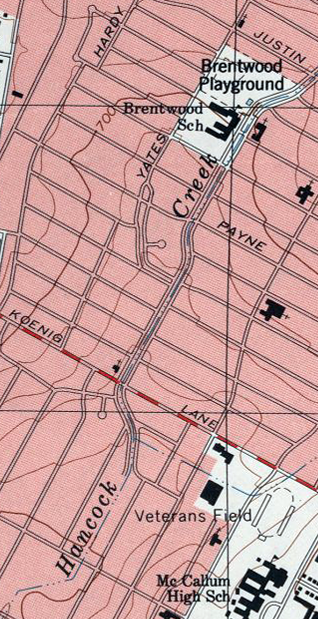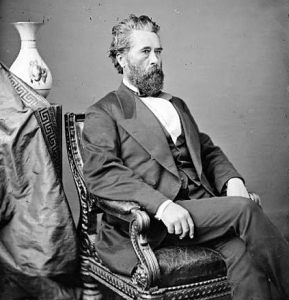Copyright 2011-2025 Susan Burneson. All rights reserved. Kindly talk with us before reproducing any content you find on the website.
Updated February 21, 2025
For the next five weeks, the blog focuses on the often-dry creek east of Brentwood Elementary and Brentwood Park. Some call the creek Arroyo Seco or Arroyo Seca. I discovered it also has other names.
In 2003, I began researching neighborhood history. I was surprised to discover maps, including a recent one from the United States Geological Survey (Austin East) (detail below), and City of Austin and Federal Emergency Management Agency documents online that refer to our waterway as Hancock Creek or the Hancock Branch of Shoal Creek. I thought of all the places with the name Hancock in Central Austin and knew there must have been a prominent Hancock family who lived here, so I continued searching. About that same time, Jean Graham shared with me a 1950s property abstract for a home in Crestview. A few years later, neighbor Julie Chappell gave me an abstract for a Violet Crown Heights property. They have been invaluable, since they include references to the Hancocks and other families who have lived here over many years.
In 2009, Crestview neighbor and Friends of Brentwood Park co-founder Emily Wilson asked if I could compile a history of the creek, as part of Crestview’s documentation to become a City of Austin Green Neighborhood. By that time, I had gathered lots of information, so the history was easy to write. I’ll be posting it here on the blog, updated from the original, in five installments. The history also appeared in five issues of the Crestview Neighborhood Association newsletter in 2010.
Hancock Creek/Arroyo Seco
 A waterway variously called Hancock Creek, the Hancock Branch of Shoal Creek, and Arroyo Seco flows through four Central Austin neighborhoods—Crestview, Brentwood, Allandale, and Rosedale.
A waterway variously called Hancock Creek, the Hancock Branch of Shoal Creek, and Arroyo Seco flows through four Central Austin neighborhoods—Crestview, Brentwood, Allandale, and Rosedale.
Beginning near where the street Arroyo Seco intersects with West St. Johns Avenue, the creek meanders south through Crestview and Brentwood, passing Brentwood Park and Brentwood Elementary School. The creek continues under Koenig Lane, Houston Street, North Loop Boulevard, and Burnet Road.
In Allandale, it flows past the Yarborough Branch of the Austin Public Library and under Hancock Drive into Rosedale. There it flows under a footbridge in a heavily wooded area between West 49th Street and Crestmont Drive. The creek flows into Shoal Creek west of Shoal Creek Boulevard and south of Hilwin Circle, near a dense stand of live oaks.
John Hancock (1824-1893), below, once owned thousands of acres in the Allandale, Brentwood, Crestview, and Rosedale areas. His stately home and grounds, once located at today’s 2200 West North Loop, was called “The Oaks.” Hancock Creek likely was named for him. His brother was George Duncan Hancock, a soldier of the Republic of Texas. John and George were sons of John Allen Hancock of Alabama. One of George’s sons was Lewis Hancock, mayor of Austin from 1895 to 1897. The Hancock neighborhood in Austin was named for Lewis. He also founded the Austin Country Club and Golf Course (now the Hancock Golf Course) in 1899.
 Born in Alabama, John Hancock moved to Austin in 1847 and became a prominent Austin lawyer, district judge, and Texas legislator. In 1861, Hancock, although a slave owner, refused to take the oath of allegiance to the Confederate States, was expelled from the Texas legislature, and left the state. After the Civil War, Hancock returned to Texas and served as a U.S. congressman for eight years. It has been suggested but not well documented that he is related to John Hancock (1737-1793), Massachusetts native and well-known patriot of the American Revolution.
Born in Alabama, John Hancock moved to Austin in 1847 and became a prominent Austin lawyer, district judge, and Texas legislator. In 1861, Hancock, although a slave owner, refused to take the oath of allegiance to the Confederate States, was expelled from the Texas legislature, and left the state. After the Civil War, Hancock returned to Texas and served as a U.S. congressman for eight years. It has been suggested but not well documented that he is related to John Hancock (1737-1793), Massachusetts native and well-known patriot of the American Revolution.
In 1852, John Hancock purchased land, then north of the Austin city limits, from Rebecca Spear, widow of George West Spear. The Hancock property was part of Spear’s original Republic of Texas land grant, which stretched north from the Colorado River to where Anderson Lane is today and between, roughly, Balcones Drive and North Lamar Boulevard. The map of the northern part of the Spear League, below, shows Hancock Creek between Shoal Creek and Abercrombie, an early railroad stop near Justin Lane and North Lamar. (More about Abercrombie here.) Hancock’s Spear League property later became part of the Brentwood and Crestview neighborhoods, among others. (Note: the top of the map, below, is west.)
 Hancock purchased 521 additional acres of land in the area from Elizabeth Moore, widow of Martin Moore, in 1866. Hancock probably never lived there, but several of his nephews and possibly some of his former slaves, including Rubin Hancock, did. The land was a dairy farm for many years. After the Hancock family sold the property in 1899, the remaining buildings gradually fell into disrepair. (More about Rubin and his family here.)
Hancock purchased 521 additional acres of land in the area from Elizabeth Moore, widow of Martin Moore, in 1866. Hancock probably never lived there, but several of his nephews and possibly some of his former slaves, including Rubin Hancock, did. The land was a dairy farm for many years. After the Hancock family sold the property in 1899, the remaining buildings gradually fell into disrepair. (More about Rubin and his family here.)
Finally, in the late 1980s, Karen and Michael Collins, owners of the property, initiated a major restoration of the Moore-Hancock Homestead, at 4811 Sinclair Avenue in Rosedale. The land to the west and north of it slopes down to Hancock Creek. Considered the only log dwelling in Austin known to survive on its original site, it is on the National Register of Historic Places and is a Recorded Texas Historic Landmark.
The 1955 version of the book Minor and Major Mansions of Early Austin, by Austin architect August Watkins Harris, includes an illustration and description of the John Hancock home. Another illustration of his home is included on page 13 of Austin Creeks, a publication created at the time of the 1976 U. S. bicentennial. I have a copy of Austin Creeks, and materials used in the production of the publication are in the Sinclair Black Papers at the Austin History Center. (Note: the 1959 version of Minor and Major Mansions of Early Austin is subtitled “Buildings of the Seat of Government” and does not include the Hancock plantation.)
Finally, John Hancock, who was white, is the second great-grandfather of actress Aisha Tyler, who is African American. The life of Aisha’s great-grandfather and John’s son, Hugh Hancock, was detailed in the TLC television program “Who Do You Think You Are?” which aired April 3, 2016. I contributed archive research to the show and learned even more about John Hancock and his family than I had known before.
Stay tuned for Part 2!
And, don’t miss our Community Links, in the right sidebar.
